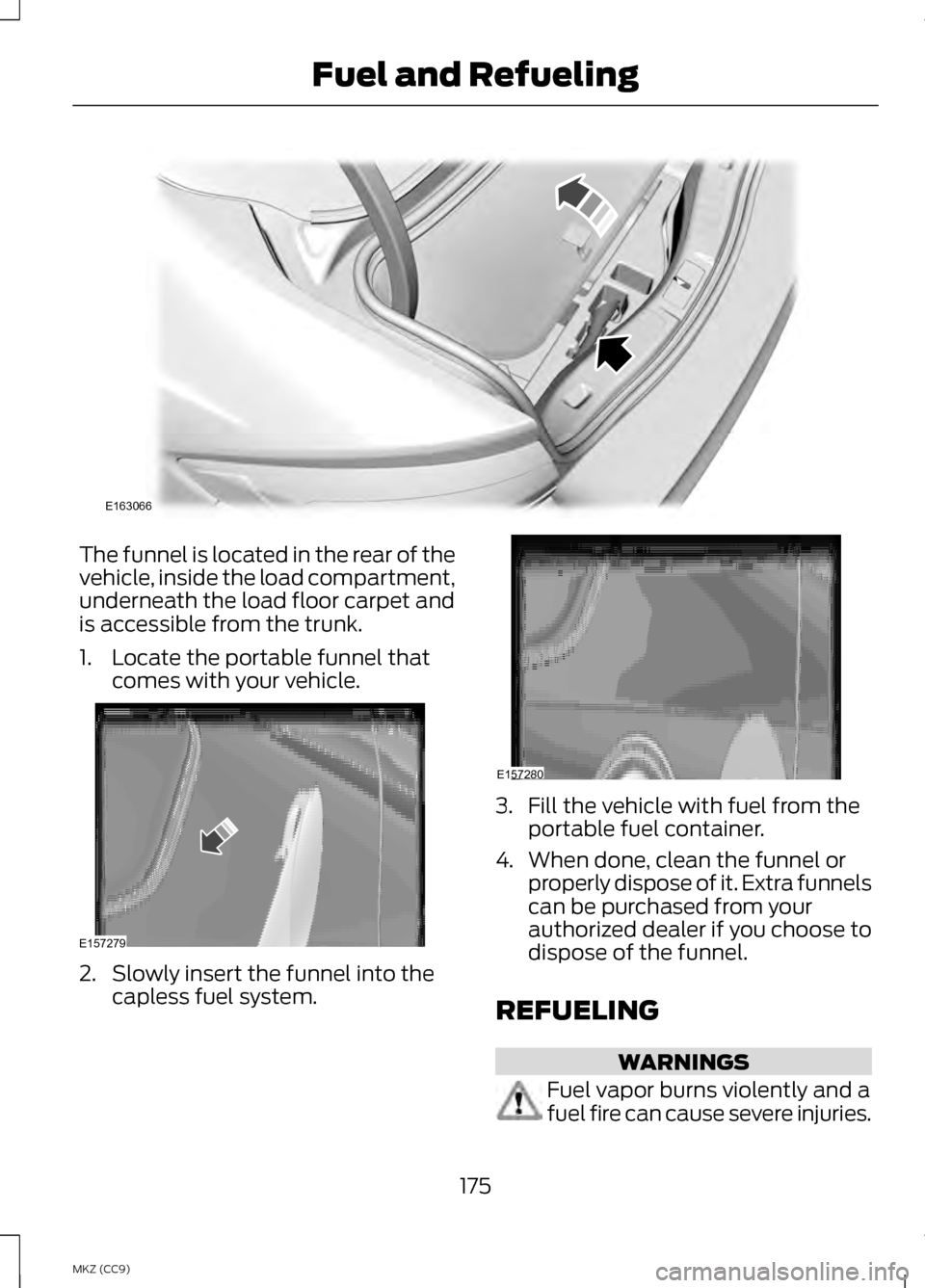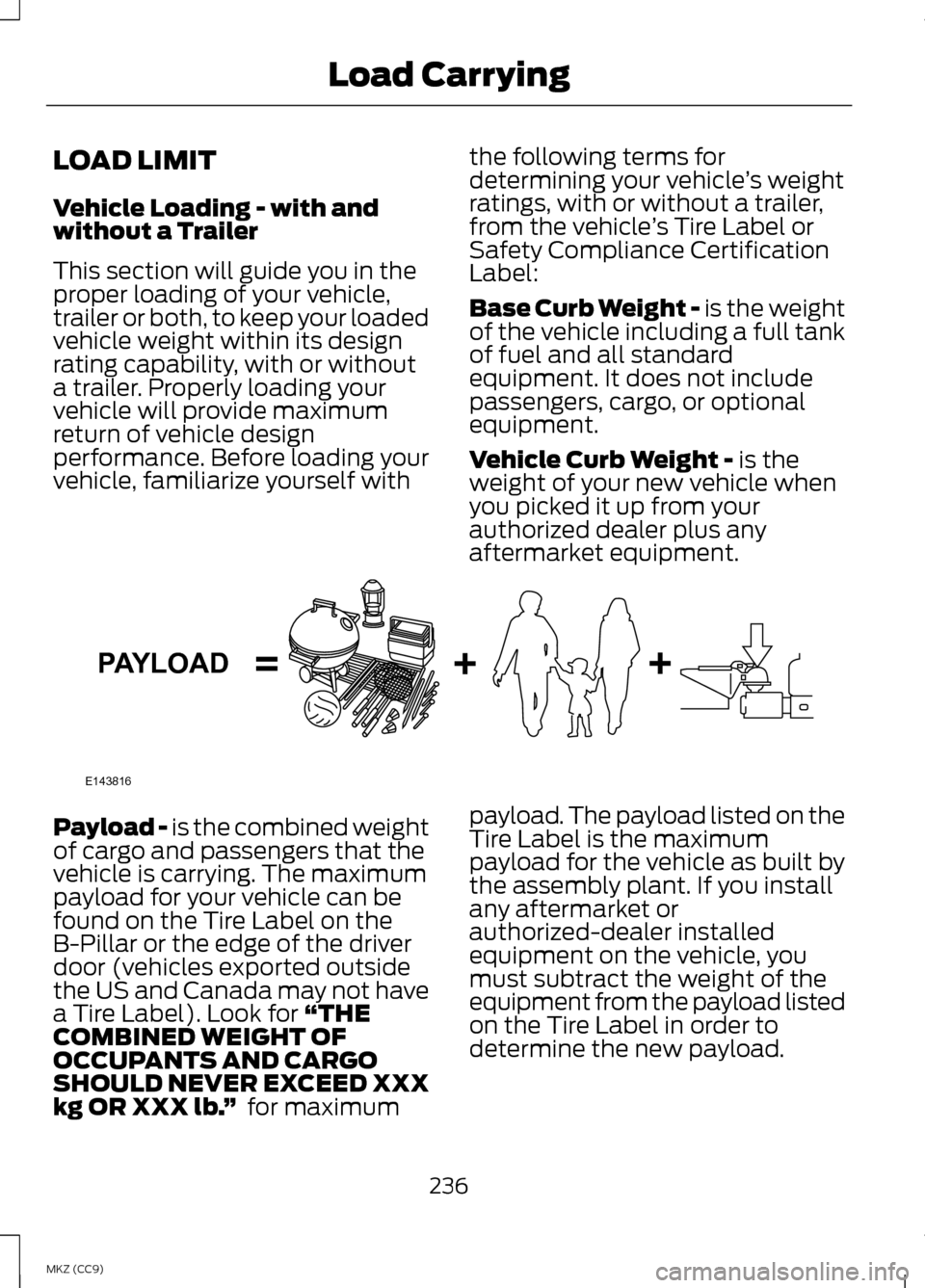2013 LINCOLN MKZ HYBRID fuel cap
[x] Cancel search: fuel capPage 176 of 475

If you have run out of fuel:
•
To start the vehicle with a keyless
ignition, just start the engine. Crank
time will be longer than usual.
• Normally, adding 1 gallon (3.8
liters) of fuel is enough to restart
the vehicle. If the vehicle is out of
fuel and on a steep grade, more
than 1 gallon (3.8 liters) may be
required.
• The service engine soon indicator
may come on.
Refilling With a Portable Fuel
Container WARNINGS
Do not insert the nozzle of
portable fuel containers or
aftermarket funnels into the capless
fuel system. This could damage the
fuel system and its seal, and may
cause fuel to run onto the ground
instead of filling the tank, which could
result in serious personal injury. WARNINGS
Do not try to pry open or push
open the capless fuel system
with foreign objects. This could
damage the fuel system and its seal
and cause injury to you or others. Note:
Do not use aftermarket funnels;
they will not work with the capless fuel
system and can damage it. The
included funnel has been specially
designed to work safely with your
vehicle.
When filling the vehicle ’s fuel tank
from a portable fuel container, use the
funnel included with the vehicle.
174
MKZ (CC9) Fuel and Refueling
Page 177 of 475

The funnel is located in the rear of the
vehicle, inside the load compartment,
underneath the load floor carpet and
is accessible from the trunk.
1. Locate the portable funnel that
comes with your vehicle. 2. Slowly insert the funnel into the
capless fuel system. 3. Fill the vehicle with fuel from the
portable fuel container.
4. When done, clean the funnel or properly dispose of it. Extra funnels
can be purchased from your
authorized dealer if you choose to
dispose of the funnel.
REFUELING WARNINGS
Fuel vapor burns violently and a
fuel fire can cause severe injuries.
175
MKZ (CC9) Fuel and RefuelingE163066 E157279 E157280
Page 178 of 475

WARNINGS
Read and follow all the
instructions on the pump island.
Switch off your engine when you
are refueling.
Do not smoke if you are near fuel
or refueling your vehicle.
Keep sparks, flames and
smoking materials away from
fuel. Stay outside your vehicle and do
not leave the fuel pump
unattended when refueling your
vehicle. This is against the law in some
places. Keep children away from the fuel
pump; never let children pump
fuel. Do not use personal electronic
devices while refueling.
Use the following guidelines to avoid
electrostatic charge build-up when
filling an ungrounded fuel container:
•
Place approved fuel container on
the ground.
• Do not fill a fuel container while it
is in your vehicle (including the
cargo area).
• Keep the fuel pump nozzle in
contact with the fuel container
while filling.
• Do not use a device that would
hold the fuel pump handle in the
fill position. Easy Fuel
™ Capless Fuel
System WARNING
The fuel system may be under
pressure. If you hear a hissing
sound near the fuel filler door, do not
refuel until the sound stops.
Otherwise, fuel may spray out, which
could cause serious personal injury. When fueling your vehicle:
1. Put the vehicle in position P and
switch the ignition off. 2. Press the center-rear edge of the
fuel filler door and release to open. 176
MKZ (CC9) Fuel and RefuelingE166527 E156032
Page 180 of 475

FUEL CONSUMPTION
Note:
The amount of usable fuel in the
empty reserve varies and should not be
relied upon to increase driving range.
When refueling your vehicle after the
fuel gauge indicates empty, you might
not be able to refuel the full amount of
the advertised capacity of the fuel tank
due to the empty reserve still present
in the tank.
Empty reserve is the amount of fuel
remaining in the tank after the fuel
gauge indicates empty. Do not rely on
this fuel for driving. The usable
capacity of the fuel tank is the amount
of fuel that can be put into the tank
after the gauge indicates empty. The
advertised capacity is the total fuel
tank size – it is the combined usable
capacity plus the empty reserve.
Filling the Tank
For consistent results when filling the
fuel tank:
• Turn the ignition off before fueling;
an inaccurate reading results if the
engine is left running.
• Use the same fill rate
(low-medium-high) each time the
tank is filled.
• Allow no more than two automatic
click-offs when filling.
Results are most accurate when the
filling method is consistent. Calculating Fuel Economy
Do not measure fuel economy during
the first 1000 miles (1600 kilometers)
of driving (this is your engine
’s
break-in period); a more accurate
measurement is obtained after 2000
miles - 3000 miles (3200 kilometers
- 4800 kilometers). Also, fuel
expense, frequency of fill ups or fuel
gauge readings are not accurate ways
to measure fuel economy.
1. Fill the fuel tank completely and record the initial odometer reading.
2. Each time you fill the tank, record the amount of fuel added.
3. After at least three to five tank fill ups, fill the fuel tank and record
the current odometer reading.
4. Subtract your initial odometer reading from the current odometer
reading.
5. Calculate fuel economy by dividing
miles traveled by gallons used (For
Metric: Multiply liters used by 100,
then divide by kilometers traveled).
Keep a record for at least one month
and record the type of driving (city or
highway). This provides an accurate
estimate of the vehicle ’s fuel economy
under current driving conditions.
Additionally, keeping records during
summer and winter show how
temperature impacts fuel economy.
In general, lower temperatures mean
lower fuel economy.
178
MKZ (CC9) Fuel and Refueling
Page 238 of 475

LOAD LIMIT
Vehicle Loading - with and
without a Trailer
This section will guide you in the
proper loading of your vehicle,
trailer or both, to keep your loaded
vehicle weight within its design
rating capability, with or without
a trailer. Properly loading your
vehicle will provide maximum
return of vehicle design
performance. Before loading your
vehicle, familiarize yourself with
the following terms for
determining your vehicle
’s weight
ratings, with or without a trailer,
from the vehicle ’s Tire Label or
Safety Compliance Certification
Label:
Base Curb Weight - is the weight
of the vehicle including a full tank
of fuel and all standard
equipment. It does not include
passengers, cargo, or optional
equipment.
Vehicle Curb Weight -
is the
weight of your new vehicle when
you picked it up from your
authorized dealer plus any
aftermarket equipment. Payload -
is the combined weight
of cargo and passengers that the
vehicle is carrying. The maximum
payload for your vehicle can be
found on the Tire Label on the
B-Pillar or the edge of the driver
door (vehicles exported outside
the US and Canada may not have
a Tire Label). Look for
“THE
COMBINED WEIGHT OF
OCCUPANTS AND CARGO
SHOULD NEVER EXCEED XXX
kg OR XXX lb. ” for maximum payload. The payload listed on the
Tire Label is the maximum
payload for the vehicle as built by
the assembly plant. If you install
any aftermarket or
authorized-dealer installed
equipment on the vehicle, you
must subtract the weight of the
equipment from the payload listed
on the Tire Label in order to
determine the new payload.
236
MKZ (CC9) Load CarryingE143816PAYLOAD
Page 282 of 475

ENGINE OIL DIPSTICK
MINA
MAXB
ENGINE OIL CHECK
Note: Check the level before starting
the engine.
Note: Make sure that the level is
between the MIN and the MAX marks.
1. Make sure that your vehicle is on level ground.
2. Turn the engine off and wait 10 minutes for the oil to drain into the
oil pan.
3. Remove the dipstick and wipe it with a clean, lint-free cloth.
Replace the dipstick and remove
it again to check the oil level.
If the level is at the MIN mark, add oil
immediately.
Adding Engine Oil
Note: Do not remove the filler cap
when the engine is running. Note:
Do not add oil further than the
MAX mark. Oil levels above the MAX
mark may cause engine damage. Only use oils certified for gasoline
engines by the American Petroleum
Institute (API). An oil with this
trademark symbol conforms to the
current engine and emission system
protection standards and fuel
economy requirements of the
International Lubricants Specification
Advisory Council (ILSAC), comprised
of U.S. and Japanese automobile
manufacturers.
1. Remove the filler cap.
2.
Add engine oil that meets the Ford
specifications. See Capacities
and Specifications (page 330).
3. Replace the filler cap. Turn it until you feel a strong resistance.
OIL CHANGE INDICATOR
RESET
To reset the oil monitoring system
after an oil change, See
General
Information (page 103).
280
MKZ (CC9) MaintenanceAB
E169062 E142732
Page 289 of 475

FUEL FILTER
Your vehicle is equipped with a
lifetime fuel filter that is integrated
with the fuel tank. Regular
maintenance or replacement is not
needed.
WASHER FLUID CHECK
WARNING
If you operate your vehicle in
temperatures below 40°F (5°C),
use washer fluid with antifreeze
protection. Failure to use washer fluid
with antifreeze protection in cold
weather could result in impaired
windshield vision and increase the risk
of injury or accident. Note:
The front and rear washer
systems are supplied from the same
reservoir.
Add fluid to fill the reservoir if the level
is low. Only use a washer fluid that
meets Ford specifications. See
Capacities and Specifications
(page 330).
State or local regulations on volatile
organic compounds may restrict the
use of methanol, a common
windshield washer antifreeze additive.
Washer fluids containing
non-methanol antifreeze agents
should be used only if they provide
cold weather protection without
damaging the vehicle ’s paint finish,
wiper blades or washer system. CHANGING THE 12V
BATTERY WARNINGS
Batteries normally produce
explosive gases which can cause
personal injury. Therefore, do not
allow flames, sparks or lighted
substances to come near the battery.
When working near the battery,
always shield your face and protect
your eyes. Always provide proper
ventilation. When lifting a plastic-cased
battery, excessive pressure on
the end walls could cause acid to flow
through the vent caps, resulting in
personal injury and damage to the
vehicle or battery. Lift the battery with
a battery carrier or with your hands on
opposite corners. Keep batteries out of reach of
children. Batteries contain
sulfuric acid. Avoid contact with skin,
eyes or clothing. Shield your eyes
when working near the battery to
protect against possible splashing of
acid solution. In case of acid contact
with skin or eyes, flush immediately
with water for a minimum of 15
minutes and get prompt medical
attention. If acid is swallowed, call a
physician immediately. Your vehicle is equipped with a
Motorcraft® maintenance-free
battery which normally does not
require additional water during its life
of service.
287
MKZ (CC9) Maintenance
Page 332 of 475

ENGINE SPECIFICATIONS
2.0L ATK iVCT Engine
Engine
122
Cubic inches
Minimum 87 octane
Required fuel
1-3-4-2
Firing order
Coil on plug (COP)
Ignition system
12.3:1
Compression
ratio
0.051 in. ± 0.002 in. (1.3 mm ± 0.05 mm)
Spark plug gap
330
MKZ (CC9) Capacities and Specifications